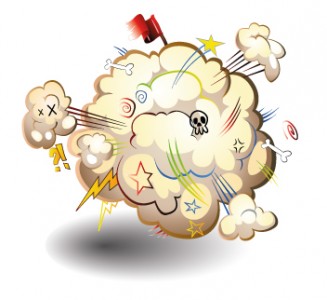“No conflict, no story” was one of the key principles of my first writing lessons. Since then, I’ve heard it and read it again and again. But what does conflict in a story mean?

According to the dictionary, a conflict is a problem, a confrontation, or a fight. Does it mean that in order to tell a good story our characters must face each other in a pitched battle? Not at all. Although conflict in literature can be represented by combat (there are thousands of stories about battles and wars), it’s a whole lot more than that. It’s what drives the plot, what makes us empathize with the characters, and what compels us to keep reading because we want to know how it will be resolved. Conflict gives life and depth to the story.
Now that we have agreed on the importance of conflict, let’s dig a little deeper into the subject. This section is about the types of conflict we can find Later on, I’ll provide the second part about how to include them naturally in your story.
Character versus Character
This is the most basic type of confrontation. Two characters (or two groups of characters) have opposite goals and fight (often physically) to achieve them. This type of conflict can be of two types:
Protagonist(s) against antagonist(s): the classical struggle between good and evil.
Protagonist(s) against protagonist(s): the characters are neither good nor bad. Both sides have their reasons for fighting, therefore the readers can empathize with them all.
Character versus Society
The protagonist (or protagonists) rebel against socially established rules. In this case, society as a whole will be the antagonistic force, but conflict will be more evident if the social order is embodied by a character (or group of characters) with personal values and motivations. For example, Tolstoy’s Anna Karenina is a character who’s torn between her feelings and the rigid social conventions of her time which are symbolized by other characters in the story.
Character versus The Superhuman
Whether they are gods, nature, vampires, ghosts, demons, chance, or fate, the superhuman is always at an advantage over the protagonist(s). It’s an unequal fight, but it keeps us in suspense precisely because of that reason. We want the protagonist(s) to win because their victory is our victory too.
Character versus Machines
This is a type of conflict widely used in science fiction where human beings fight the rebellion of the machines they themselves have created such as in Blade Runner. Another good example is the Battlestar Galactica series which begins with a conflict between humans and machines. However, as the episodes go on, the latter adopt human features which is what turns the “character versus machine” confrontation into a much more thought-provoking “character versus character” conflict.
Character versus Self
No matter what type of main conflict the story describes, we should also include internal conflicts in the characters’ minds. This doesn’t mean that all of our characters should have existential doubts. A character can also be in conflict with himself or herself because of everyday issues like deciding whether to tell a friend that his wife is cheating on him. These little struggles we all fight in our lives give a new dimension to the characters and the story. They make them more real, and as a result, they are more interesting.
In the fight between Darth Vader and Luke Skywalker in Star Wars Episode VI: Return of the Jedi, there’s an obvious external conflict. The characters are two antagonistic forces fighting each other with their laser swords. What makes the scene extraordinary is both characters’ internal struggle. Will Luke be carried away by hatred? Will Darth Vader betray the Emperor to save his son? Inner conflicts are much more fascinating than external confrontations.
You can keep reading about conflict in “How to Introduce Conflict in a Story.”
Related Posts:
The Key Elements of the Creative Process
Four Key Story Elements: Summary, Plot, Structure, and Suspense
How to Give Depth to your Characters
 This site uses cookies. By continuing to browse the site, you are agreeing to
This site uses cookies. By continuing to browse the site, you are agreeing to 



There are no comments in this entry. Go ahead and leave yours!